Effective Reading and Note-Taking Skills in Higher Education
VerifiedAdded on 2023/06/14
|8
|2602
|71
Report
AI Summary
This report explores the importance of reading and note-making skills for students in higher education. It defines reading and note-making, highlighting their significance in academic success. The report details various reading techniques, including scanning, skimming, surveying, detailed reading, and revision reading, explaining how each method can be used to improve comprehension and efficiency. Furthermore, it discusses effective note-taking methods such as the outline method, Cornell method, mind mapping, and sentence note-taking, providing insights into how students can best capture and retain information from lectures and study materials. The report concludes by emphasizing the complementary nature of reading and note-making, advocating for their combined use to enhance learning and academic performance. Desklib provides a platform with study tools for students to access this and other helpful assignments.
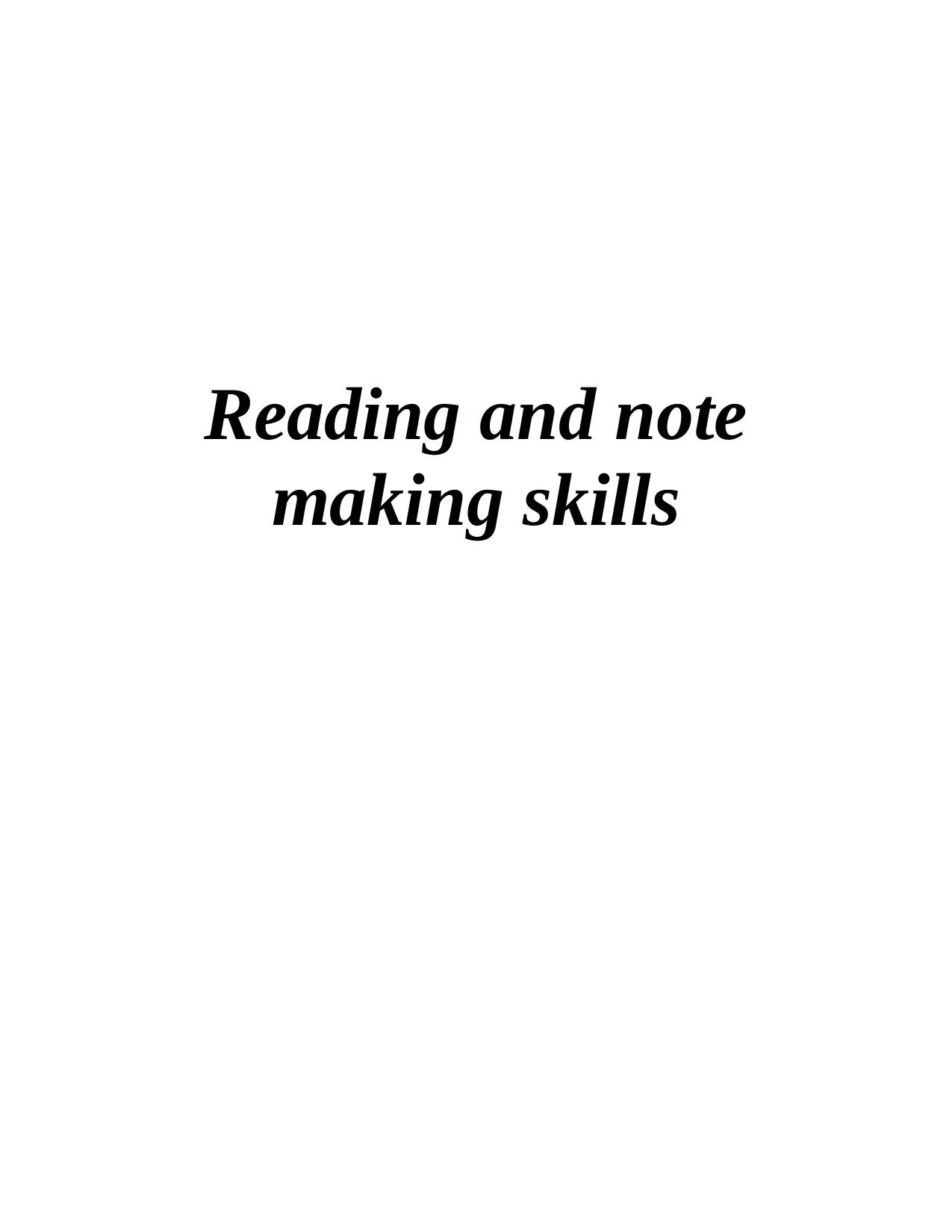
Reading and note
making skills
making skills
Paraphrase This Document
Need a fresh take? Get an instant paraphrase of this document with our AI Paraphraser
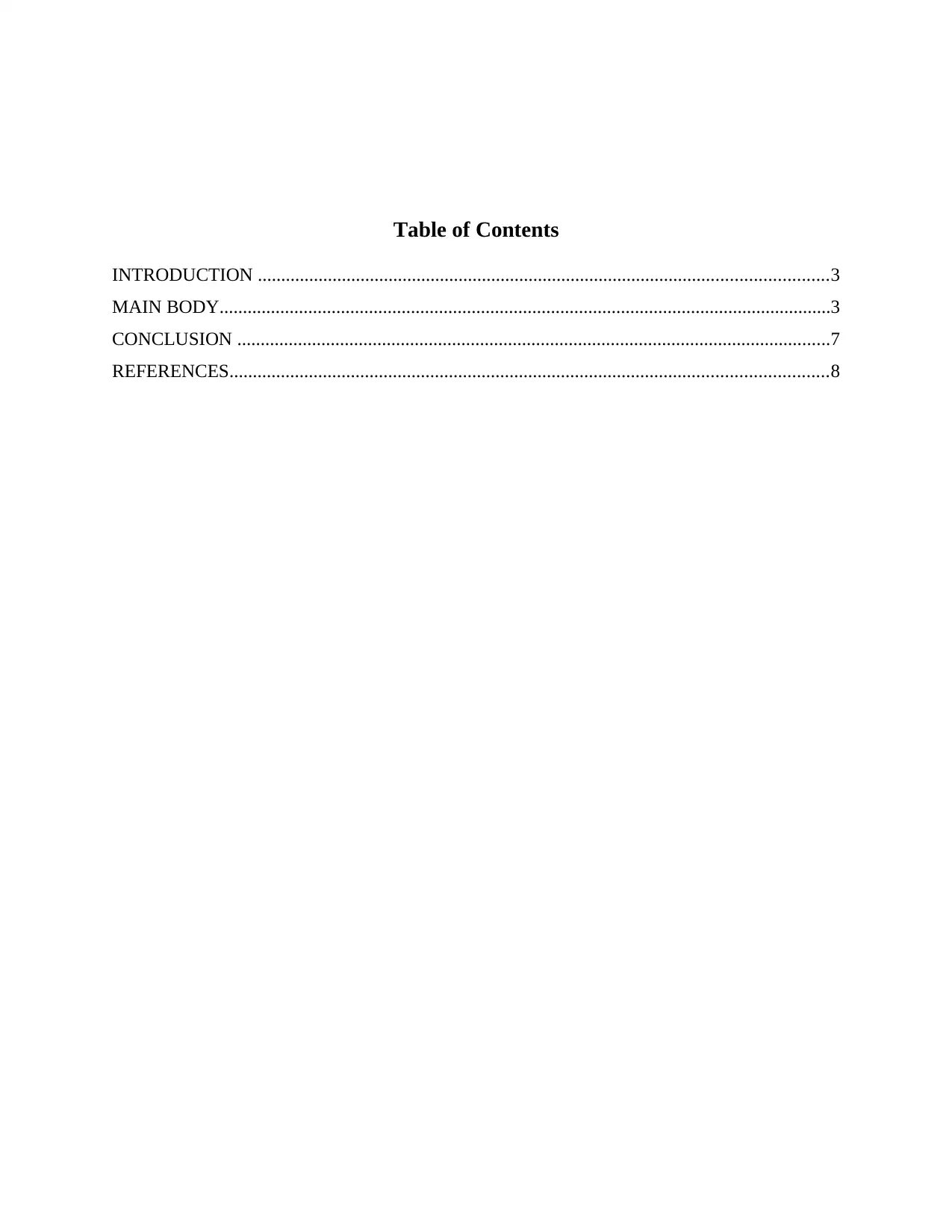
Table of Contents
INTRODUCTION ..........................................................................................................................3
MAIN BODY...................................................................................................................................3
CONCLUSION ...............................................................................................................................7
REFERENCES................................................................................................................................8
INTRODUCTION ..........................................................................................................................3
MAIN BODY...................................................................................................................................3
CONCLUSION ...............................................................................................................................7
REFERENCES................................................................................................................................8
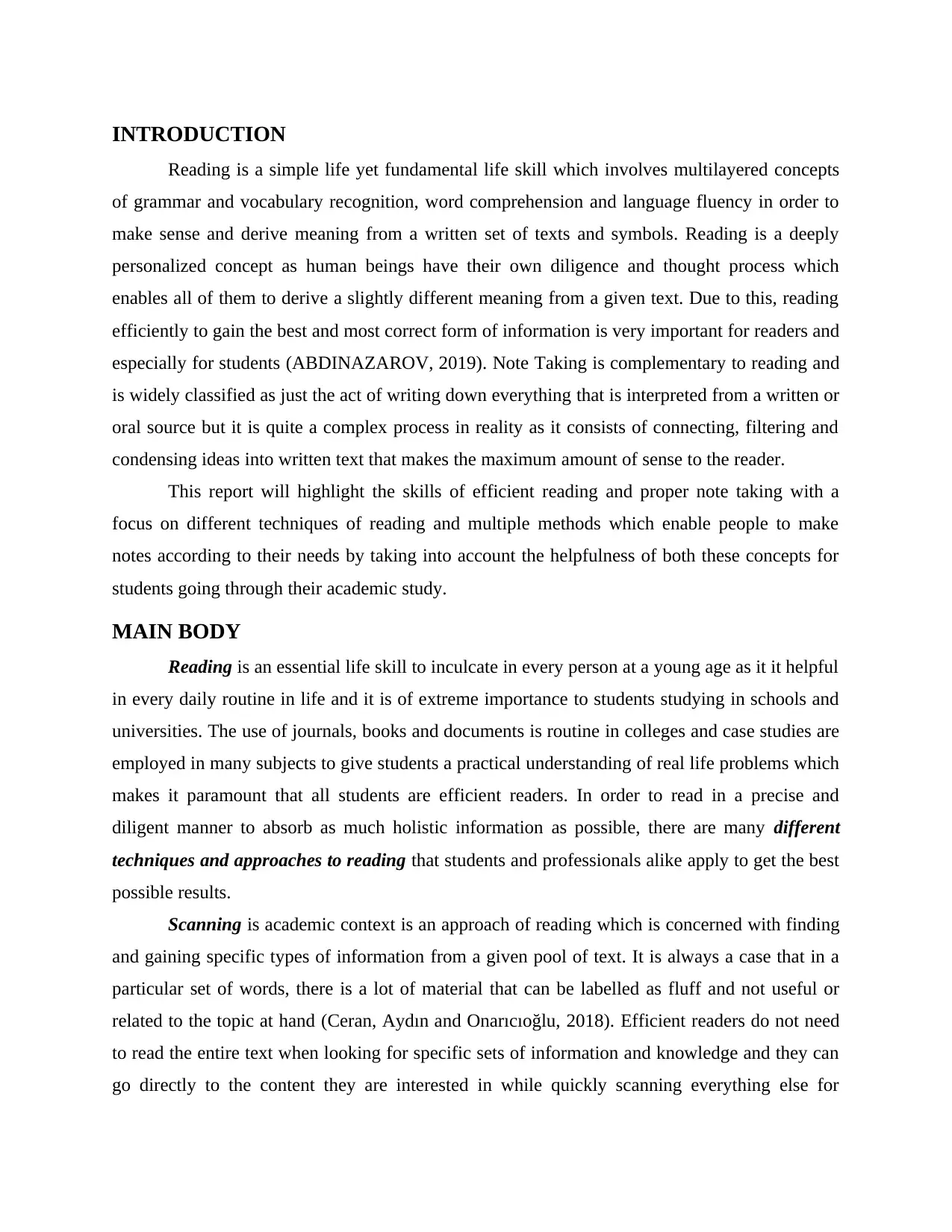
INTRODUCTION
Reading is a simple life yet fundamental life skill which involves multilayered concepts
of grammar and vocabulary recognition, word comprehension and language fluency in order to
make sense and derive meaning from a written set of texts and symbols. Reading is a deeply
personalized concept as human beings have their own diligence and thought process which
enables all of them to derive a slightly different meaning from a given text. Due to this, reading
efficiently to gain the best and most correct form of information is very important for readers and
especially for students (ABDINAZAROV, 2019). Note Taking is complementary to reading and
is widely classified as just the act of writing down everything that is interpreted from a written or
oral source but it is quite a complex process in reality as it consists of connecting, filtering and
condensing ideas into written text that makes the maximum amount of sense to the reader.
This report will highlight the skills of efficient reading and proper note taking with a
focus on different techniques of reading and multiple methods which enable people to make
notes according to their needs by taking into account the helpfulness of both these concepts for
students going through their academic study.
MAIN BODY
Reading is an essential life skill to inculcate in every person at a young age as it it helpful
in every daily routine in life and it is of extreme importance to students studying in schools and
universities. The use of journals, books and documents is routine in colleges and case studies are
employed in many subjects to give students a practical understanding of real life problems which
makes it paramount that all students are efficient readers. In order to read in a precise and
diligent manner to absorb as much holistic information as possible, there are many different
techniques and approaches to reading that students and professionals alike apply to get the best
possible results.
Scanning is academic context is an approach of reading which is concerned with finding
and gaining specific types of information from a given pool of text. It is always a case that in a
particular set of words, there is a lot of material that can be labelled as fluff and not useful or
related to the topic at hand (Ceran, Aydın and Onarıcıoğlu, 2018). Efficient readers do not need
to read the entire text when looking for specific sets of information and knowledge and they can
go directly to the content they are interested in while quickly scanning everything else for
Reading is a simple life yet fundamental life skill which involves multilayered concepts
of grammar and vocabulary recognition, word comprehension and language fluency in order to
make sense and derive meaning from a written set of texts and symbols. Reading is a deeply
personalized concept as human beings have their own diligence and thought process which
enables all of them to derive a slightly different meaning from a given text. Due to this, reading
efficiently to gain the best and most correct form of information is very important for readers and
especially for students (ABDINAZAROV, 2019). Note Taking is complementary to reading and
is widely classified as just the act of writing down everything that is interpreted from a written or
oral source but it is quite a complex process in reality as it consists of connecting, filtering and
condensing ideas into written text that makes the maximum amount of sense to the reader.
This report will highlight the skills of efficient reading and proper note taking with a
focus on different techniques of reading and multiple methods which enable people to make
notes according to their needs by taking into account the helpfulness of both these concepts for
students going through their academic study.
MAIN BODY
Reading is an essential life skill to inculcate in every person at a young age as it it helpful
in every daily routine in life and it is of extreme importance to students studying in schools and
universities. The use of journals, books and documents is routine in colleges and case studies are
employed in many subjects to give students a practical understanding of real life problems which
makes it paramount that all students are efficient readers. In order to read in a precise and
diligent manner to absorb as much holistic information as possible, there are many different
techniques and approaches to reading that students and professionals alike apply to get the best
possible results.
Scanning is academic context is an approach of reading which is concerned with finding
and gaining specific types of information from a given pool of text. It is always a case that in a
particular set of words, there is a lot of material that can be labelled as fluff and not useful or
related to the topic at hand (Ceran, Aydın and Onarıcıoğlu, 2018). Efficient readers do not need
to read the entire text when looking for specific sets of information and knowledge and they can
go directly to the content they are interested in while quickly scanning everything else for
⊘ This is a preview!⊘
Do you want full access?
Subscribe today to unlock all pages.

Trusted by 1+ million students worldwide
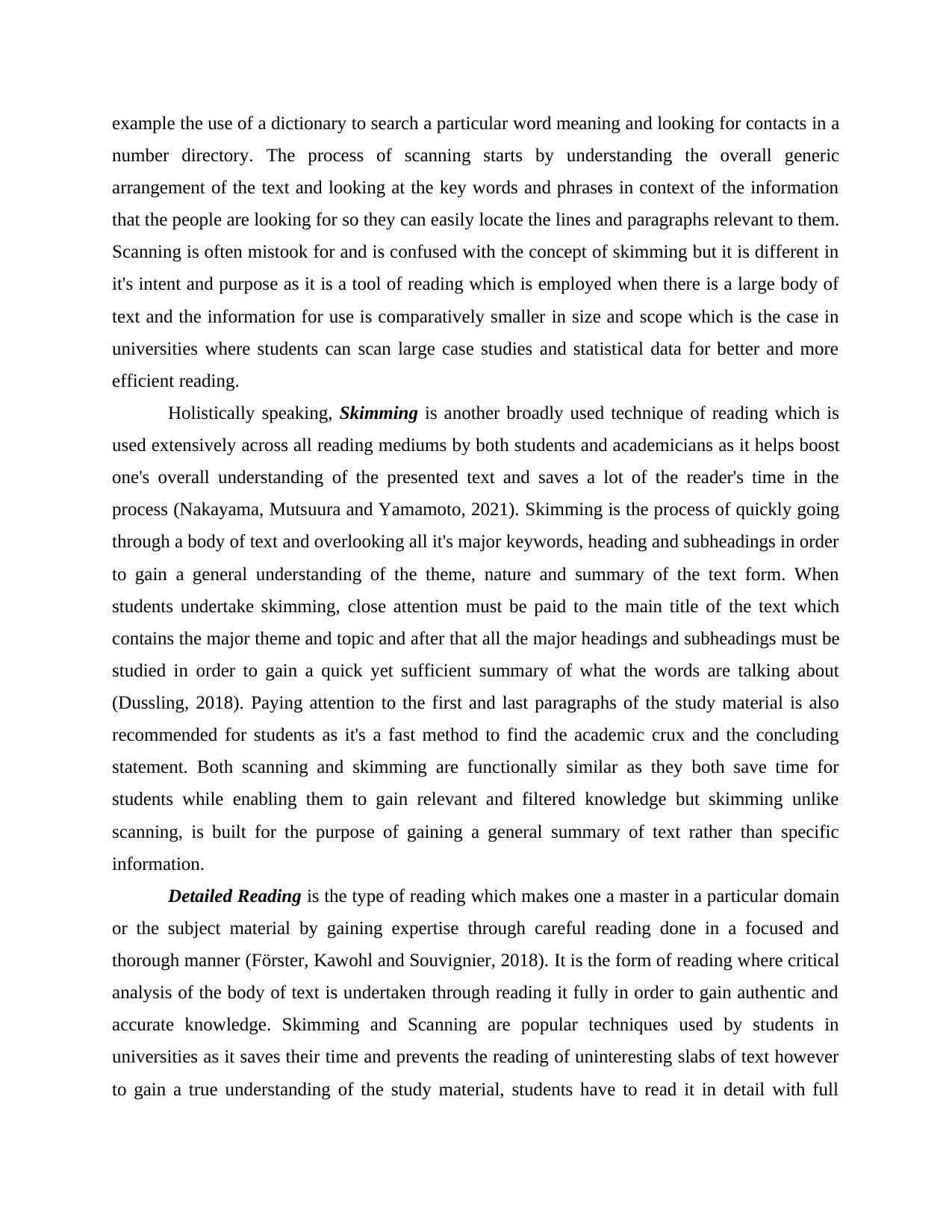
example the use of a dictionary to search a particular word meaning and looking for contacts in a
number directory. The process of scanning starts by understanding the overall generic
arrangement of the text and looking at the key words and phrases in context of the information
that the people are looking for so they can easily locate the lines and paragraphs relevant to them.
Scanning is often mistook for and is confused with the concept of skimming but it is different in
it's intent and purpose as it is a tool of reading which is employed when there is a large body of
text and the information for use is comparatively smaller in size and scope which is the case in
universities where students can scan large case studies and statistical data for better and more
efficient reading.
Holistically speaking, Skimming is another broadly used technique of reading which is
used extensively across all reading mediums by both students and academicians as it helps boost
one's overall understanding of the presented text and saves a lot of the reader's time in the
process (Nakayama, Mutsuura and Yamamoto, 2021). Skimming is the process of quickly going
through a body of text and overlooking all it's major keywords, heading and subheadings in order
to gain a general understanding of the theme, nature and summary of the text form. When
students undertake skimming, close attention must be paid to the main title of the text which
contains the major theme and topic and after that all the major headings and subheadings must be
studied in order to gain a quick yet sufficient summary of what the words are talking about
(Dussling, 2018). Paying attention to the first and last paragraphs of the study material is also
recommended for students as it's a fast method to find the academic crux and the concluding
statement. Both scanning and skimming are functionally similar as they both save time for
students while enabling them to gain relevant and filtered knowledge but skimming unlike
scanning, is built for the purpose of gaining a general summary of text rather than specific
information.
Detailed Reading is the type of reading which makes one a master in a particular domain
or the subject material by gaining expertise through careful reading done in a focused and
thorough manner (Förster, Kawohl and Souvignier, 2018). It is the form of reading where critical
analysis of the body of text is undertaken through reading it fully in order to gain authentic and
accurate knowledge. Skimming and Scanning are popular techniques used by students in
universities as it saves their time and prevents the reading of uninteresting slabs of text however
to gain a true understanding of the study material, students have to read it in detail with full
number directory. The process of scanning starts by understanding the overall generic
arrangement of the text and looking at the key words and phrases in context of the information
that the people are looking for so they can easily locate the lines and paragraphs relevant to them.
Scanning is often mistook for and is confused with the concept of skimming but it is different in
it's intent and purpose as it is a tool of reading which is employed when there is a large body of
text and the information for use is comparatively smaller in size and scope which is the case in
universities where students can scan large case studies and statistical data for better and more
efficient reading.
Holistically speaking, Skimming is another broadly used technique of reading which is
used extensively across all reading mediums by both students and academicians as it helps boost
one's overall understanding of the presented text and saves a lot of the reader's time in the
process (Nakayama, Mutsuura and Yamamoto, 2021). Skimming is the process of quickly going
through a body of text and overlooking all it's major keywords, heading and subheadings in order
to gain a general understanding of the theme, nature and summary of the text form. When
students undertake skimming, close attention must be paid to the main title of the text which
contains the major theme and topic and after that all the major headings and subheadings must be
studied in order to gain a quick yet sufficient summary of what the words are talking about
(Dussling, 2018). Paying attention to the first and last paragraphs of the study material is also
recommended for students as it's a fast method to find the academic crux and the concluding
statement. Both scanning and skimming are functionally similar as they both save time for
students while enabling them to gain relevant and filtered knowledge but skimming unlike
scanning, is built for the purpose of gaining a general summary of text rather than specific
information.
Detailed Reading is the type of reading which makes one a master in a particular domain
or the subject material by gaining expertise through careful reading done in a focused and
thorough manner (Förster, Kawohl and Souvignier, 2018). It is the form of reading where critical
analysis of the body of text is undertaken through reading it fully in order to gain authentic and
accurate knowledge. Skimming and Scanning are popular techniques used by students in
universities as it saves their time and prevents the reading of uninteresting slabs of text however
to gain a true understanding of the study material, students have to read it in detail with full
Paraphrase This Document
Need a fresh take? Get an instant paraphrase of this document with our AI Paraphraser
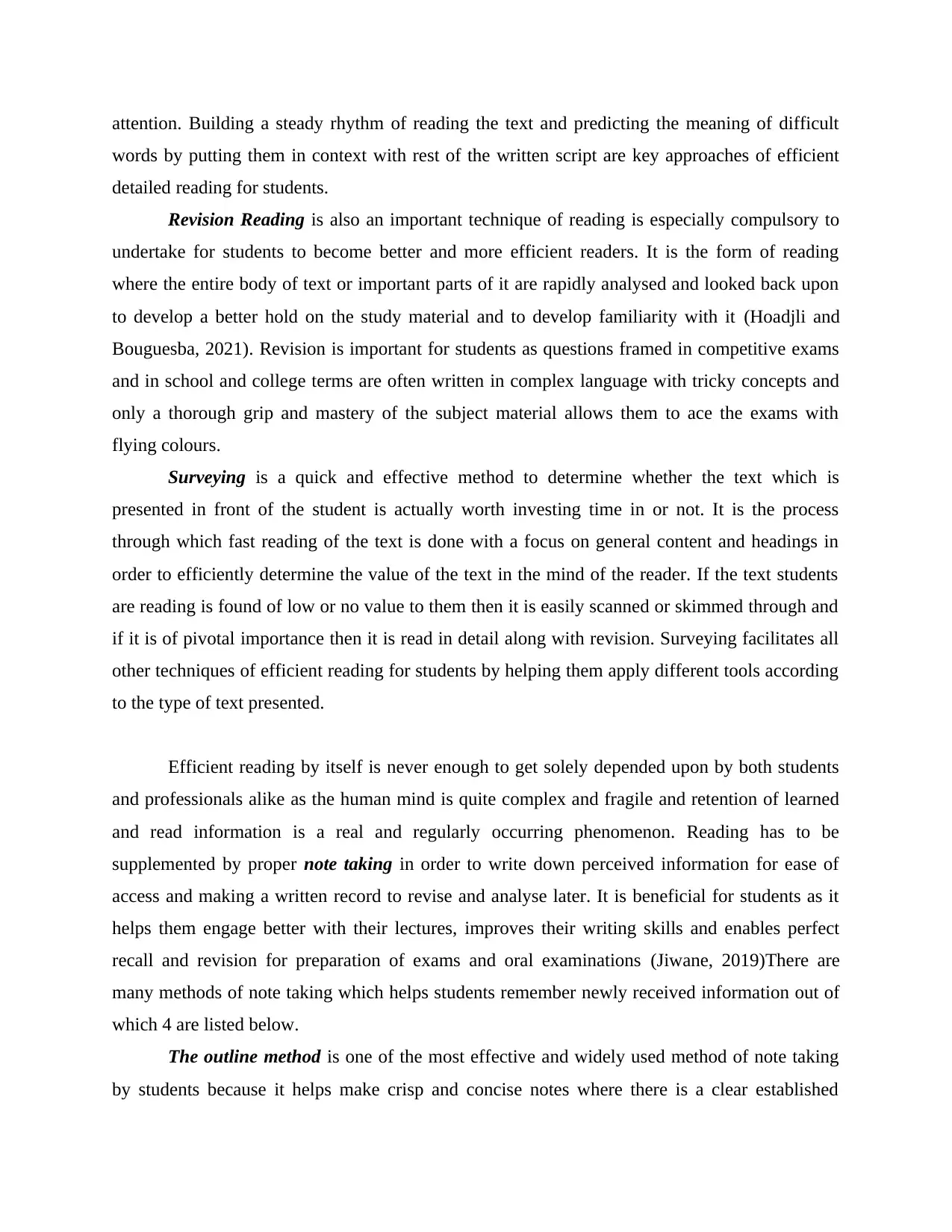
attention. Building a steady rhythm of reading the text and predicting the meaning of difficult
words by putting them in context with rest of the written script are key approaches of efficient
detailed reading for students.
Revision Reading is also an important technique of reading is especially compulsory to
undertake for students to become better and more efficient readers. It is the form of reading
where the entire body of text or important parts of it are rapidly analysed and looked back upon
to develop a better hold on the study material and to develop familiarity with it (Hoadjli and
Bouguesba, 2021). Revision is important for students as questions framed in competitive exams
and in school and college terms are often written in complex language with tricky concepts and
only a thorough grip and mastery of the subject material allows them to ace the exams with
flying colours.
Surveying is a quick and effective method to determine whether the text which is
presented in front of the student is actually worth investing time in or not. It is the process
through which fast reading of the text is done with a focus on general content and headings in
order to efficiently determine the value of the text in the mind of the reader. If the text students
are reading is found of low or no value to them then it is easily scanned or skimmed through and
if it is of pivotal importance then it is read in detail along with revision. Surveying facilitates all
other techniques of efficient reading for students by helping them apply different tools according
to the type of text presented.
Efficient reading by itself is never enough to get solely depended upon by both students
and professionals alike as the human mind is quite complex and fragile and retention of learned
and read information is a real and regularly occurring phenomenon. Reading has to be
supplemented by proper note taking in order to write down perceived information for ease of
access and making a written record to revise and analyse later. It is beneficial for students as it
helps them engage better with their lectures, improves their writing skills and enables perfect
recall and revision for preparation of exams and oral examinations (Jiwane, 2019)There are
many methods of note taking which helps students remember newly received information out of
which 4 are listed below.
The outline method is one of the most effective and widely used method of note taking
by students because it helps make crisp and concise notes where there is a clear established
words by putting them in context with rest of the written script are key approaches of efficient
detailed reading for students.
Revision Reading is also an important technique of reading is especially compulsory to
undertake for students to become better and more efficient readers. It is the form of reading
where the entire body of text or important parts of it are rapidly analysed and looked back upon
to develop a better hold on the study material and to develop familiarity with it (Hoadjli and
Bouguesba, 2021). Revision is important for students as questions framed in competitive exams
and in school and college terms are often written in complex language with tricky concepts and
only a thorough grip and mastery of the subject material allows them to ace the exams with
flying colours.
Surveying is a quick and effective method to determine whether the text which is
presented in front of the student is actually worth investing time in or not. It is the process
through which fast reading of the text is done with a focus on general content and headings in
order to efficiently determine the value of the text in the mind of the reader. If the text students
are reading is found of low or no value to them then it is easily scanned or skimmed through and
if it is of pivotal importance then it is read in detail along with revision. Surveying facilitates all
other techniques of efficient reading for students by helping them apply different tools according
to the type of text presented.
Efficient reading by itself is never enough to get solely depended upon by both students
and professionals alike as the human mind is quite complex and fragile and retention of learned
and read information is a real and regularly occurring phenomenon. Reading has to be
supplemented by proper note taking in order to write down perceived information for ease of
access and making a written record to revise and analyse later. It is beneficial for students as it
helps them engage better with their lectures, improves their writing skills and enables perfect
recall and revision for preparation of exams and oral examinations (Jiwane, 2019)There are
many methods of note taking which helps students remember newly received information out of
which 4 are listed below.
The outline method is one of the most effective and widely used method of note taking
by students because it helps make crisp and concise notes where there is a clear established
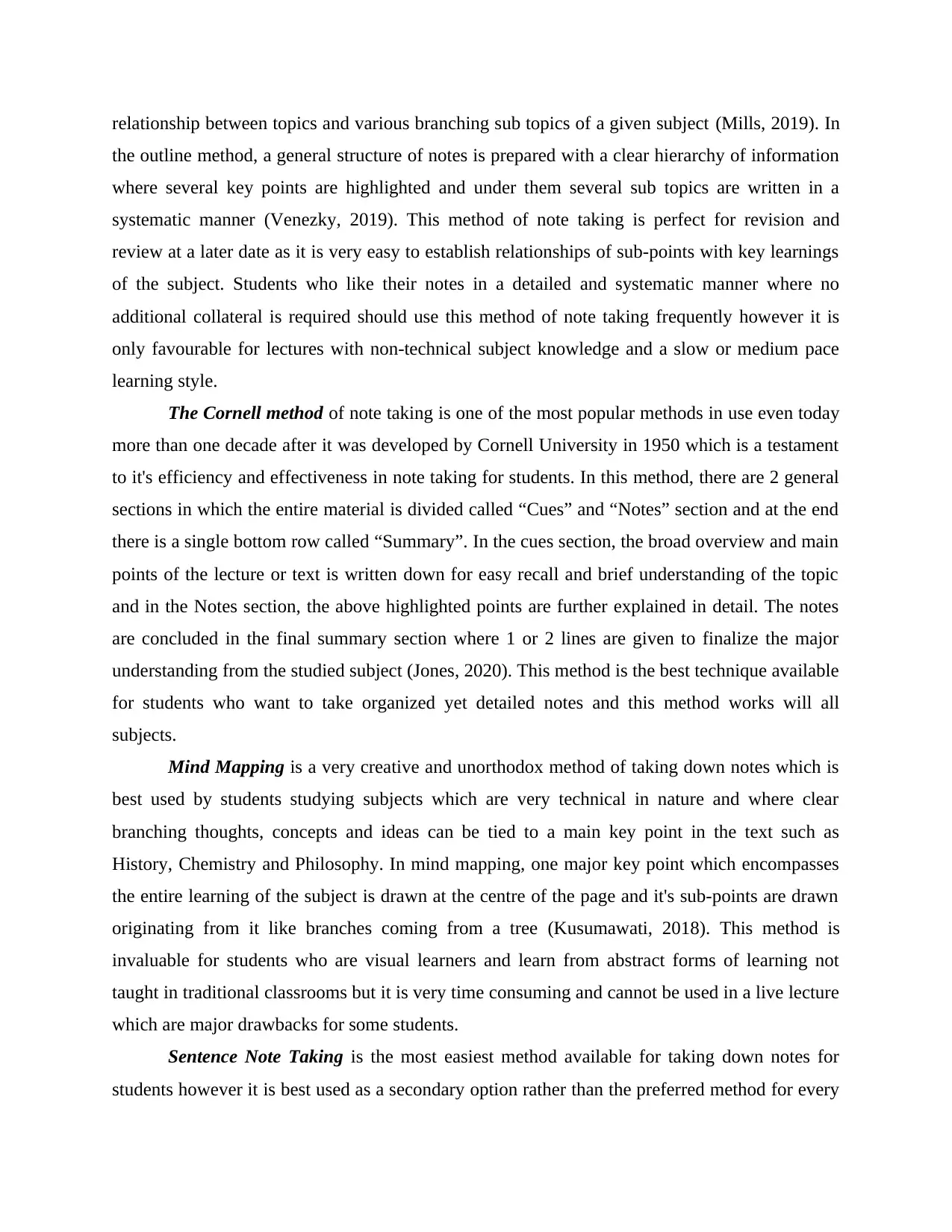
relationship between topics and various branching sub topics of a given subject (Mills, 2019). In
the outline method, a general structure of notes is prepared with a clear hierarchy of information
where several key points are highlighted and under them several sub topics are written in a
systematic manner (Venezky, 2019). This method of note taking is perfect for revision and
review at a later date as it is very easy to establish relationships of sub-points with key learnings
of the subject. Students who like their notes in a detailed and systematic manner where no
additional collateral is required should use this method of note taking frequently however it is
only favourable for lectures with non-technical subject knowledge and a slow or medium pace
learning style.
The Cornell method of note taking is one of the most popular methods in use even today
more than one decade after it was developed by Cornell University in 1950 which is a testament
to it's efficiency and effectiveness in note taking for students. In this method, there are 2 general
sections in which the entire material is divided called “Cues” and “Notes” section and at the end
there is a single bottom row called “Summary”. In the cues section, the broad overview and main
points of the lecture or text is written down for easy recall and brief understanding of the topic
and in the Notes section, the above highlighted points are further explained in detail. The notes
are concluded in the final summary section where 1 or 2 lines are given to finalize the major
understanding from the studied subject (Jones, 2020). This method is the best technique available
for students who want to take organized yet detailed notes and this method works will all
subjects.
Mind Mapping is a very creative and unorthodox method of taking down notes which is
best used by students studying subjects which are very technical in nature and where clear
branching thoughts, concepts and ideas can be tied to a main key point in the text such as
History, Chemistry and Philosophy. In mind mapping, one major key point which encompasses
the entire learning of the subject is drawn at the centre of the page and it's sub-points are drawn
originating from it like branches coming from a tree (Kusumawati, 2018). This method is
invaluable for students who are visual learners and learn from abstract forms of learning not
taught in traditional classrooms but it is very time consuming and cannot be used in a live lecture
which are major drawbacks for some students.
Sentence Note Taking is the most easiest method available for taking down notes for
students however it is best used as a secondary option rather than the preferred method for every
the outline method, a general structure of notes is prepared with a clear hierarchy of information
where several key points are highlighted and under them several sub topics are written in a
systematic manner (Venezky, 2019). This method of note taking is perfect for revision and
review at a later date as it is very easy to establish relationships of sub-points with key learnings
of the subject. Students who like their notes in a detailed and systematic manner where no
additional collateral is required should use this method of note taking frequently however it is
only favourable for lectures with non-technical subject knowledge and a slow or medium pace
learning style.
The Cornell method of note taking is one of the most popular methods in use even today
more than one decade after it was developed by Cornell University in 1950 which is a testament
to it's efficiency and effectiveness in note taking for students. In this method, there are 2 general
sections in which the entire material is divided called “Cues” and “Notes” section and at the end
there is a single bottom row called “Summary”. In the cues section, the broad overview and main
points of the lecture or text is written down for easy recall and brief understanding of the topic
and in the Notes section, the above highlighted points are further explained in detail. The notes
are concluded in the final summary section where 1 or 2 lines are given to finalize the major
understanding from the studied subject (Jones, 2020). This method is the best technique available
for students who want to take organized yet detailed notes and this method works will all
subjects.
Mind Mapping is a very creative and unorthodox method of taking down notes which is
best used by students studying subjects which are very technical in nature and where clear
branching thoughts, concepts and ideas can be tied to a main key point in the text such as
History, Chemistry and Philosophy. In mind mapping, one major key point which encompasses
the entire learning of the subject is drawn at the centre of the page and it's sub-points are drawn
originating from it like branches coming from a tree (Kusumawati, 2018). This method is
invaluable for students who are visual learners and learn from abstract forms of learning not
taught in traditional classrooms but it is very time consuming and cannot be used in a live lecture
which are major drawbacks for some students.
Sentence Note Taking is the most easiest method available for taking down notes for
students however it is best used as a secondary option rather than the preferred method for every
⊘ This is a preview!⊘
Do you want full access?
Subscribe today to unlock all pages.

Trusted by 1+ million students worldwide
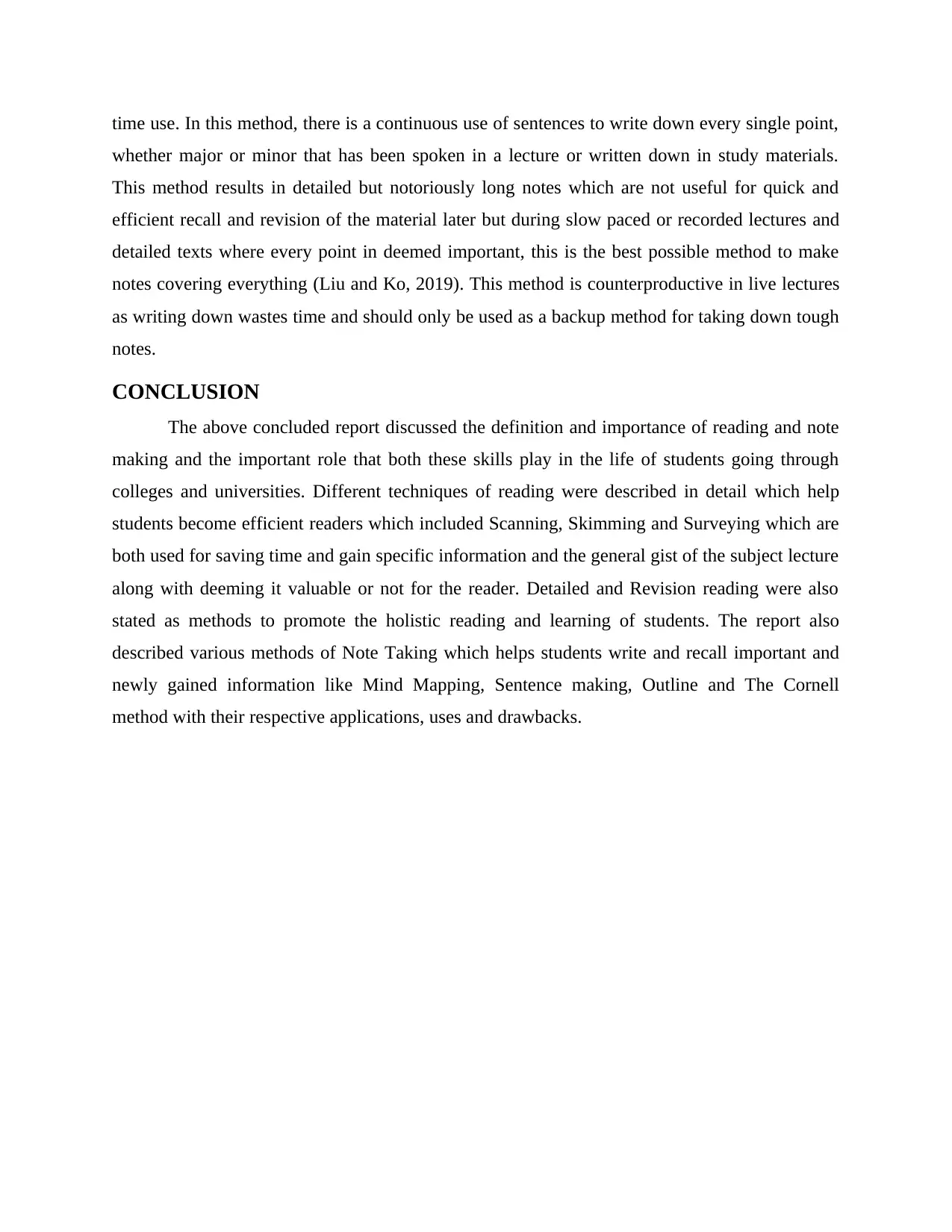
time use. In this method, there is a continuous use of sentences to write down every single point,
whether major or minor that has been spoken in a lecture or written down in study materials.
This method results in detailed but notoriously long notes which are not useful for quick and
efficient recall and revision of the material later but during slow paced or recorded lectures and
detailed texts where every point in deemed important, this is the best possible method to make
notes covering everything (Liu and Ko, 2019). This method is counterproductive in live lectures
as writing down wastes time and should only be used as a backup method for taking down tough
notes.
CONCLUSION
The above concluded report discussed the definition and importance of reading and note
making and the important role that both these skills play in the life of students going through
colleges and universities. Different techniques of reading were described in detail which help
students become efficient readers which included Scanning, Skimming and Surveying which are
both used for saving time and gain specific information and the general gist of the subject lecture
along with deeming it valuable or not for the reader. Detailed and Revision reading were also
stated as methods to promote the holistic reading and learning of students. The report also
described various methods of Note Taking which helps students write and recall important and
newly gained information like Mind Mapping, Sentence making, Outline and The Cornell
method with their respective applications, uses and drawbacks.
whether major or minor that has been spoken in a lecture or written down in study materials.
This method results in detailed but notoriously long notes which are not useful for quick and
efficient recall and revision of the material later but during slow paced or recorded lectures and
detailed texts where every point in deemed important, this is the best possible method to make
notes covering everything (Liu and Ko, 2019). This method is counterproductive in live lectures
as writing down wastes time and should only be used as a backup method for taking down tough
notes.
CONCLUSION
The above concluded report discussed the definition and importance of reading and note
making and the important role that both these skills play in the life of students going through
colleges and universities. Different techniques of reading were described in detail which help
students become efficient readers which included Scanning, Skimming and Surveying which are
both used for saving time and gain specific information and the general gist of the subject lecture
along with deeming it valuable or not for the reader. Detailed and Revision reading were also
stated as methods to promote the holistic reading and learning of students. The report also
described various methods of Note Taking which helps students write and recall important and
newly gained information like Mind Mapping, Sentence making, Outline and The Cornell
method with their respective applications, uses and drawbacks.
Paraphrase This Document
Need a fresh take? Get an instant paraphrase of this document with our AI Paraphraser
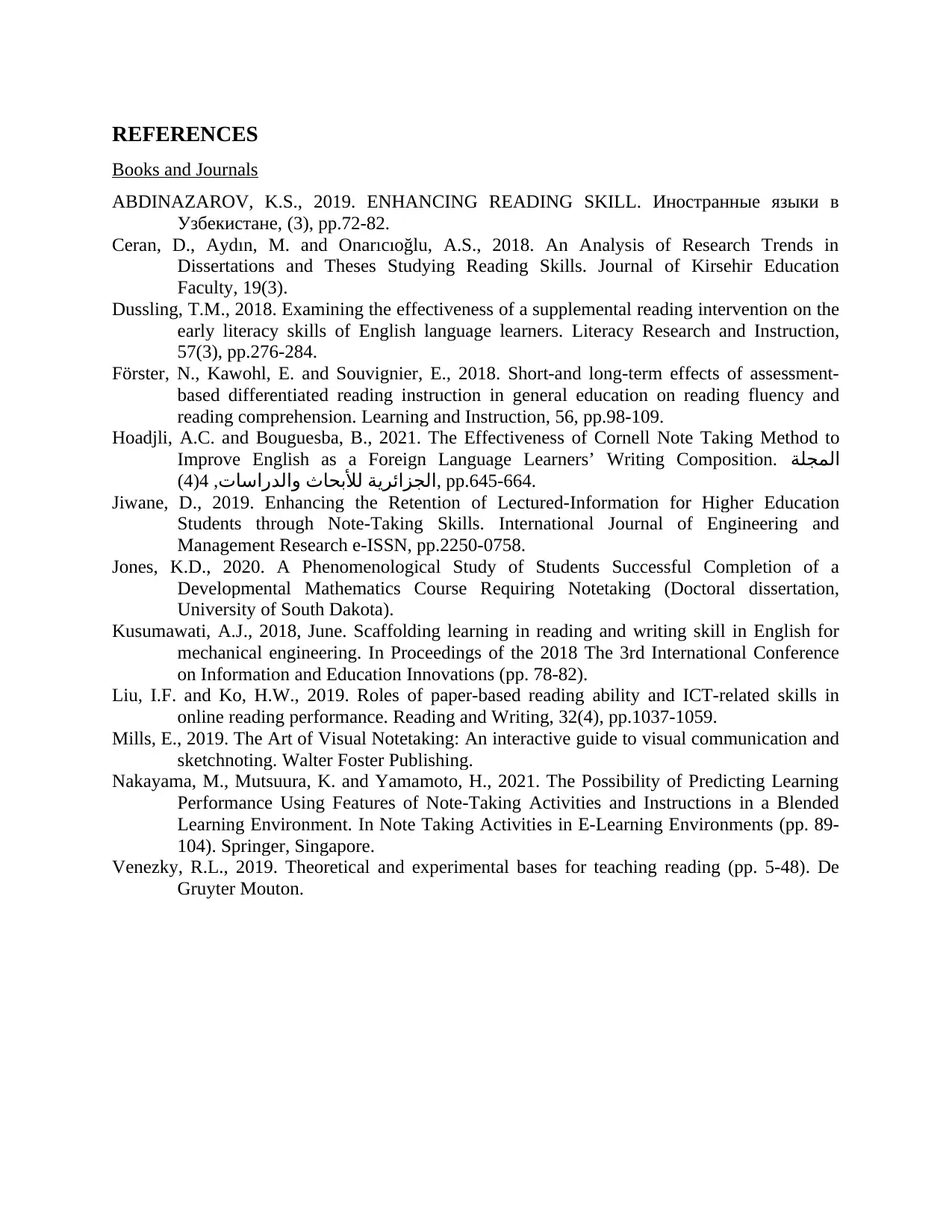
REFERENCES
Books and Journals
ABDINAZAROV, K.S., 2019. ENHANCING READING SKILL. Иностранные языки в
Узбекистане, (3), pp.72-82.
Ceran, D., Aydın, M. and Onarıcıoğlu, A.S., 2018. An Analysis of Research Trends in
Dissertations and Theses Studying Reading Skills. Journal of Kirsehir Education
Faculty, 19(3).
Dussling, T.M., 2018. Examining the effectiveness of a supplemental reading intervention on the
early literacy skills of English language learners. Literacy Research and Instruction,
57(3), pp.276-284.
Förster, N., Kawohl, E. and Souvignier, E., 2018. Short-and long-term effects of assessment-
based differentiated reading instruction in general education on reading fluency and
reading comprehension. Learning and Instruction, 56, pp.98-109.
Hoadjli, A.C. and Bouguesba, B., 2021. The Effectiveness of Cornell Note Taking Method to
Improve English as a Foreign Language Learners’ Writing Composition. المجلة
,الجزائرية لألبحاث والدراسات4)4( , pp.645-664.
Jiwane, D., 2019. Enhancing the Retention of Lectured-Information for Higher Education
Students through Note-Taking Skills. International Journal of Engineering and
Management Research e-ISSN, pp.2250-0758.
Jones, K.D., 2020. A Phenomenological Study of Students Successful Completion of a
Developmental Mathematics Course Requiring Notetaking (Doctoral dissertation,
University of South Dakota).
Kusumawati, A.J., 2018, June. Scaffolding learning in reading and writing skill in English for
mechanical engineering. In Proceedings of the 2018 The 3rd International Conference
on Information and Education Innovations (pp. 78-82).
Liu, I.F. and Ko, H.W., 2019. Roles of paper-based reading ability and ICT-related skills in
online reading performance. Reading and Writing, 32(4), pp.1037-1059.
Mills, E., 2019. The Art of Visual Notetaking: An interactive guide to visual communication and
sketchnoting. Walter Foster Publishing.
Nakayama, M., Mutsuura, K. and Yamamoto, H., 2021. The Possibility of Predicting Learning
Performance Using Features of Note-Taking Activities and Instructions in a Blended
Learning Environment. In Note Taking Activities in E-Learning Environments (pp. 89-
104). Springer, Singapore.
Venezky, R.L., 2019. Theoretical and experimental bases for teaching reading (pp. 5-48). De
Gruyter Mouton.
Books and Journals
ABDINAZAROV, K.S., 2019. ENHANCING READING SKILL. Иностранные языки в
Узбекистане, (3), pp.72-82.
Ceran, D., Aydın, M. and Onarıcıoğlu, A.S., 2018. An Analysis of Research Trends in
Dissertations and Theses Studying Reading Skills. Journal of Kirsehir Education
Faculty, 19(3).
Dussling, T.M., 2018. Examining the effectiveness of a supplemental reading intervention on the
early literacy skills of English language learners. Literacy Research and Instruction,
57(3), pp.276-284.
Förster, N., Kawohl, E. and Souvignier, E., 2018. Short-and long-term effects of assessment-
based differentiated reading instruction in general education on reading fluency and
reading comprehension. Learning and Instruction, 56, pp.98-109.
Hoadjli, A.C. and Bouguesba, B., 2021. The Effectiveness of Cornell Note Taking Method to
Improve English as a Foreign Language Learners’ Writing Composition. المجلة
,الجزائرية لألبحاث والدراسات4)4( , pp.645-664.
Jiwane, D., 2019. Enhancing the Retention of Lectured-Information for Higher Education
Students through Note-Taking Skills. International Journal of Engineering and
Management Research e-ISSN, pp.2250-0758.
Jones, K.D., 2020. A Phenomenological Study of Students Successful Completion of a
Developmental Mathematics Course Requiring Notetaking (Doctoral dissertation,
University of South Dakota).
Kusumawati, A.J., 2018, June. Scaffolding learning in reading and writing skill in English for
mechanical engineering. In Proceedings of the 2018 The 3rd International Conference
on Information and Education Innovations (pp. 78-82).
Liu, I.F. and Ko, H.W., 2019. Roles of paper-based reading ability and ICT-related skills in
online reading performance. Reading and Writing, 32(4), pp.1037-1059.
Mills, E., 2019. The Art of Visual Notetaking: An interactive guide to visual communication and
sketchnoting. Walter Foster Publishing.
Nakayama, M., Mutsuura, K. and Yamamoto, H., 2021. The Possibility of Predicting Learning
Performance Using Features of Note-Taking Activities and Instructions in a Blended
Learning Environment. In Note Taking Activities in E-Learning Environments (pp. 89-
104). Springer, Singapore.
Venezky, R.L., 2019. Theoretical and experimental bases for teaching reading (pp. 5-48). De
Gruyter Mouton.
1 out of 8
Related Documents
Your All-in-One AI-Powered Toolkit for Academic Success.
+13062052269
info@desklib.com
Available 24*7 on WhatsApp / Email
![[object Object]](/_next/static/media/star-bottom.7253800d.svg)
Unlock your academic potential
Copyright © 2020–2025 A2Z Services. All Rights Reserved. Developed and managed by ZUCOL.



